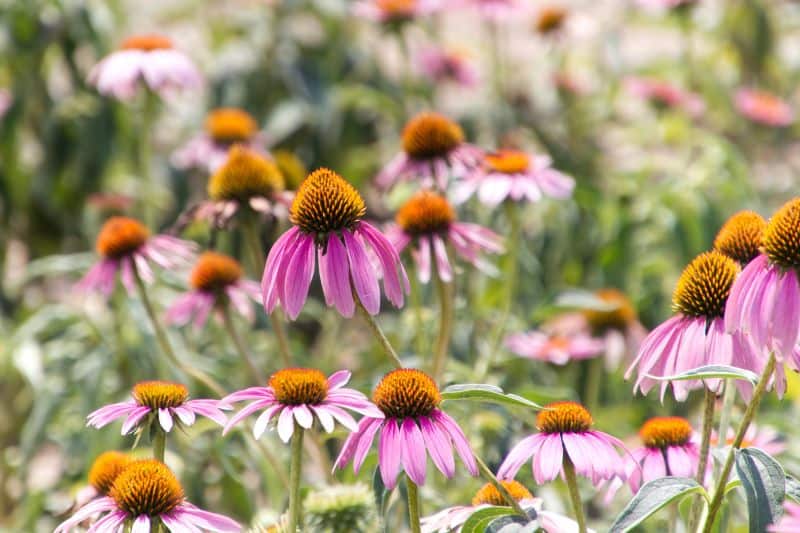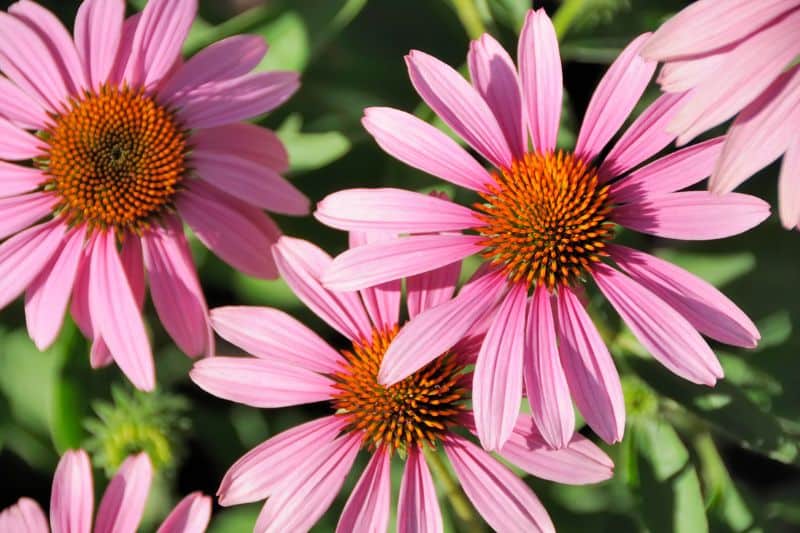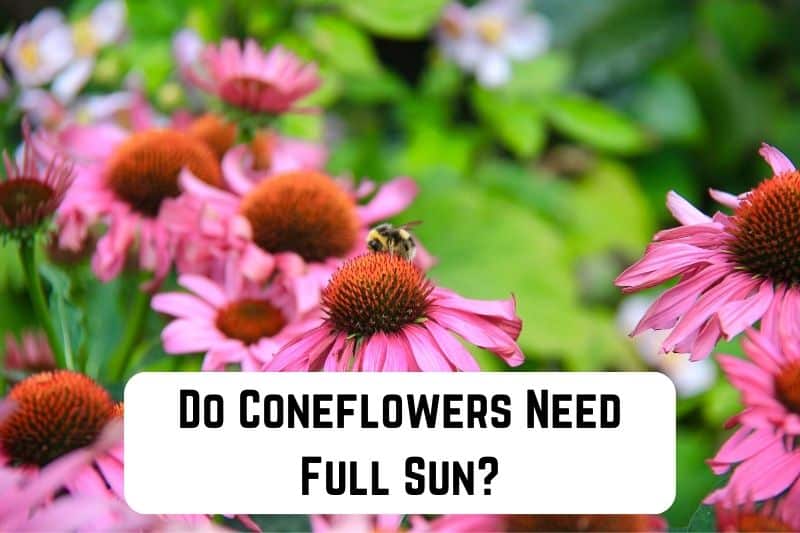Coneflowers are loved for their multiple benefits, whether their appealing garden interest or herbal tea medicinal benefits. Coneflowers offer a wonderful display of bright purple, pink, yellow, and white blossoms. These single and double-petaled flowers are a favorite of many pollinators and songbirds. But, do coneflowers need full sun?
A cross-section of environmental factors significantly determines how well these long bloomers develop and how you enjoy their benefits. Coneflowers are favored for their heat and drought resistance.
You must consider essential environmental factors, like their sunlight needs, to ensure the best results. Here’s a complete guide into coneflower sunlight needs (if, any) to ensure the perennials keep coming back year after year.
Read: Do Maple Trees Lose Their Leaves?
Do Coneflowers Need Full Sun or Shade?
Coneflowers fall under the group of heat and drought-tolerant herbaceous perennials – thriving best in these conditions. While they come in many varieties -including hybridized versions, coneflowers have similar natural lighting needs.
Coneflowers need full sun to grow and thrive to their full potential. Coneflowers can grow in partial shade. However, you will notice issues with their growth. In parietal shade, they don’t grow nearly as much in height, and their blossoms aren’t as abundant or bright in color.
Also known as echinacea, coneflowers are long-lived herbaceous perennials – so they come back every year. Whether in the wild or garden, non-hybridized coneflowers self-seed. If you pass up on deadhead flowers after they fade, seeds fall to the ground, encouraging growth and spread.
Growing in full sun conditions allows the perennials to thrive for long – without the risk of disease or death. Appropriate sun exposure also produces lively blossoms in your garden from mid-summer through fall (before the first frost) every year. Since they are self-seeding, proper sunlight exposure ensures more growth and blooming the following season.
Sunlight acts as fuel for the coneflower powerhouse. It helps to drive photosynthesis, yielding enough energy for growth and development. The more sunlight there is, the better the plant grows. The physical growth and development of the plant usually displays this.
Exposing coneflowers to full sun helps strengthen your plant stems while yielding more flowers. This also explains why coneflowers growing in partial shade have shorter and slightly weaker stems with few flowers. In partial shade, plants will also have thin and tender stems. This further explains why plants that don’t get enough sun tend to have elongated and droopy stems.
Here’s what full sunlight does for coneflowers;
- Promotes rich and abundant flower blooming
- Provides the brightest flower colors
- Longer blooming period from mid-summer through fall
- Healthier plant and stronger stems – growing to at least 4 feet tall
How Many Hours of Sun Do Coneflowers Need?
Coneflowers need at least 6 to 8 hours of full sun exposure daily. Anything less than 6 hours daily means the plant doesn’t grow to its full potential. But this doesn’t mean some shade is a bad idea, either.
Most sun-loving flowering plants, even coneflowers, benefit the most from the morning sun. The morning sun is less intense while the direct afternoon sun comes with a great deal of heat. Too much heat can fade and scorch the flowers and leaves.

Coneflowers naturally grow in the open prairies where you’d expect them to enjoy full direct sun all day. However, large canopy trees with space-out limbs are also spread across these settings, creating the perfect sun filter. While enjoying sun exposure all day, the trees lend out afternoon cover to filter out the extreme sunlight and heat.
The best way to enjoy the same results in your garden as in the wild is to replicate the settings. You want your coneflowers to enjoy full morning sun and partial shade in the afternoon. This, in turn, delivers just the right amount of sunlight to the plants without the heat damage.
Plant coneflowers in south or southwest-facing parts of your property. This will naturally expose the coneflowers to the more forgiving morning sun while providing some shade from the intense afternoon sun.
Alternatively, if you grow your coneflowers in pots, you can always move them around throughout the day. While enjoying adequate sun, the coneflowers’ natural growth in clumps and self-seeding nature means you get even more plants each year.
Tip: West-facing spots are okay, but rarely provide full sun (partial sun all day). On the other hand, keep coneflowers away from the east or north of your property as they will not receive enough sun, if at all.
Can Coneflowers Grow in Indirect Sunlight?
Coneflowers can grow in indirect sunlight to a certain degree. While they prefer full sun, they can also grow in partial shade (or indirect sunlight). However, when grown in indirect sunlight, they don’t produce nearly as good results.
Partial sun (or partial shade) means that the plant receives between 3 and 6 hours of sunlight per day – and the rest in shade! Coneflowers need at least 6 hours of full sun, especially the morning sun with some afternoon partial shade. When grown in partial shade (indirect sunlight) all day, they won’t produce the best results.
Growing in partial sun, Coneflowers…
- Don’t grow to their full size (less than 4 feet tall)
- Don’t produce as many flowers
- May not develop the brightest colors
Tip: If you live in an extremely warm and dry climate, growing coneflowers in partial sun (3 to 6 hours of sunlight daily) isn’t a bad idea.
What Happens If Coneflowers Don’t Get Enough Sun?
Coneflowers are at a higher risk of experiencing many health-related problems if they don’t get enough sun. If you solely depend on coneflower interest for pollination in your garden, inadequate sunlight can disrupt this too.
Full sun exposure ( 6 to 8 hours of sunlight daily) offers the best outcomes. Partial sun (3 to 6 hours of sunlight daily) will not kill coneflowers nor provide the best results. Without adequate sunlight, even partial sun, coneflowers are less likely to make.

Here’s what happens to coneflowers if they don’t get enough sun;
- They flop or droop (stem elongation)
- Fewer or no flowers at all
- Overall weaker growth
- Increased risks of pest infestation and diseases, such as aphids, leaf spot, or powdery mildew
Adequate sun exposure does more than just foster coneflower growth and blooming. It plays an important environmental role. Coneflowers typically grow in clumps. This explains why the plant number increases over time around the same place if you don’t deadhead or cut them.
Unfortunately, without proper sun exposure, this can clog ventilation and increase moisture buildup around the plants. As a result, white dusting forms on your plant – indicating powdery mildew disease. Anthracnose is another mildew, and mold-related fungal disease associated with too much moisture on the plant.
Similarly, the blossoms of the coneflower are a magnet for pollinators. Their bright purple, pink, red, orange, yellow, and white blossoms paired with their sweet-scented nectar attract everything from hummingbirds to bees and butterflies.
During fall, their clusters of seeds or “cones” at the flower center turn into bird feeders. Without enough sunlight, coneflowers die and the surrounding fauna, i.e. birds and pollinators, lack their fair share of food.
Can Coneflowers Get Too Much Sun?
Coneflowers can get too much sun. While they are sun-loving, drought and heat-resistant, too much sunlight can do damage. If you notice wilting, drooping, yellow spots, or sunburn on coneflower leaves, intense sunlight is the culprit.
Intense sunlight comes with extreme heat. If you live in a coastal area or other dry and warm climate, your coneflowers are more likely to experience this issue. The afternoon sun in these warmer areas tends to be more intense and hot.
Full exposure to the excruciating afternoon sun can potentially damage coneflowers. Providing some shade to the plant can mitigate problems associated with too much sun. Grow coneflowers in an area with full exposure to the more forgiving morning sun. Make sure this spot provides some shade from the more intense afternoon sun – or move the plants daily.
Read: How Long Do Pecan Trees Live?
How To Grow and Care For Coneflowers?
- Coneflowers need at least 6 weeks to establish their roots
- Plant coneflowers in early fall or spring – to protect them from frost
- Sow seeds in open grounds – ¼ inch deep into the soil
- Or, transplant 2-inch tall seedlings into the ground or pot
- Water the plant every other day until established
- Decrease watering consistency after a year depending on the location and climate
- Droopy or wilting leaves are a sign of a dehydrated coneflower plant
- Provide at least 6 hours of sunlight daily (full morning sun and partial afternoon sun)
- Humidity increases the risks of pest infestation and disease
- Grow coneflowers in well-drained loamy soils with pH 6.5 to 7.0
- Coneflowers will survive in sand or clay blended with a potting soil mix (and soil conditioner in a pot)
- Add some slow-release fertilizer or garden compost in early spring to promote summer-blooming
- Deadhead coneflowers to encourage reblooming and to keep the plant neat
- Keep the plants through fall to encourage bird activity (they feed on cone/seed clusters)






